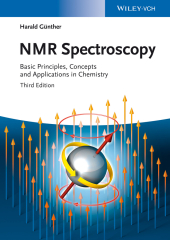 Neuerscheinungen 2013Stand: 2020-01-07 |
Schnellsuche
ISBN/Stichwort/Autor
|
Herderstraße 10
10625 Berlin
Tel.: 030 315 714 16
Fax 030 315 714 14
info@buchspektrum.de |

Harald Günther
NMR Spectroscopy
Basic Principles, Concepts and Applications in Chemistry
3rd ed. 2013. 734 p. 24,5 cm
Verlag/Jahr: WILEY-VCH 2013
ISBN: 3-527-33000-3 (3527330003)
Neue ISBN: 978-3-527-33000-3 (9783527330003)
Preis und Lieferzeit: Bitte klicken
Auch die komplett überarbeitete 3. Auflage dieses bewährten Lehrbuchs überzeugt durch Klarheit, eine didaktisch gelungene Aufbereitung des Stoffes und ein hohes Maß an Praxisbezug. Das komplexe Thema wird mit einem Mindestmaß an Mathematik erklärt - ideal für Studenten, die die Grundlagen der NMR-Spektroskopie verstehen und das Verfahren effizient und präzise anwenden möchten.
Die neue Auflage ist vollständig überarbeitet und aktualisiert. So sind rund 25% der Inhalte neu, darunter auch Kapitel zur biologischen NMR-Spektroskopie sowie viele Beispiele aus der organischen Chemie. Daher stellt dieses Fachbuch auch für Studenten in Grund- und Hauptstudium verwandter Fachrichtungen wie der Biochemie, Medizinischen Chemie, Pharmazeutischen Chemie und Materialwissenschaften einen wertvollen Leitfaden dar. Außerdem findet der Leser eine Vielzahl von Übungsaufgaben mit zugehörigen Lösungen.
Nuclear magnetic resonance (NMR) spectroscopy is one of the most powerful and widely used techniques in chemical research for investigating structures and dynamics of molecules. Advanced methods can even be utilized for structure determinations of biopolymers, for example proteins or nucleic acids. NMR is also used in medicine for magnetic resonance imaging (MRI). The method is based on spectral lines of different atomic nuclei that are excited when a strong magnetic field and a radiofrequency transmitter are applied. The method is very sensitive to the features of molecular structure because also the neighboring atoms influence the signals from individual nuclei and this is
important for determining the 3D-structure of molecules.
This new edition of the popular classic has a clear style and a highly practical, mostly non-mathematical approach. Many examples are taken from organic and organometallic chemistry, making this book an invaluable guide to undergraduate and graduate students of organic chemistry, biochemistry, spectroscopy or physical chemistry, and to researchers using this well-established and extremely important technique. Problems and solutions are included.
"Few good textbooks on NMR Spectroscopy are available at either the undergraduate or graduate levels. For those who want to go beyond elementary organic chemistry but without delving into all the mathematics Friebolin´s book is probably the best among this category." ( Journal of Chemical Education , 5 June 2014)
Harald Günther studied Chemistry at the Universities of Stuttgart and Heidelberg, Germany, followed by a Postdoctoral Fellowship at Mellon Institute, Pittsburgh, USA. He then became an assistant at the Institute of Organic Chemistry at the University of Cologne, Germany, where he also completed his habilitation. He became Professor of Organic Chemistry at the University of Cologne in 1970, and at the University of Siegen, Germany, in 1978.


